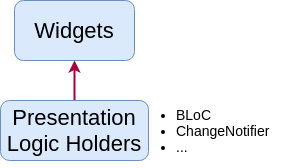Clean Code Architecture Flutter
Reso Coder Clean Architecture is a popular way of designing software that separates it into different layers, making it easy to manage and modify.
Reso Coder Clean Architecture is a way of designing software that makes it easy to manage and modify. In Flutter apps, Clean Architecture is used to organize the code into different layers. Each layer has a specific job to do, and they work together to make the app work. It was created by Reso Coder, a software developer who is passionate about creating high-quality software. In this blog, we will explore what Reso Coder Clean Architecture is, its benefits, and how it can be implemented in a Flutter app.
There are three layers in Clean Architecture for Flutter:

Presentation Layer:

The presentation layer consists of two parts, UI(Screens, widgets) and Business Logic(state management like BLoC, Change Notifier Provider, Riverpod, etc). This layer is responsible for the app's user interface. It displays the data from the app and handles user input. An example of this layer would be to show a dropdown menu, etc.
Domain Layer:

This is the core of the app, containing the code that represents the interfaces. This layer contains the data entity, repository, and usecase. This layer is used to connect Data Layer and presentation layer.
Data Layer:

This layer is responsible for handling the data sources, such as databases, APIs, etc. This layer contains data models, repository implementation, and data sources. Data sources can be of two types: Local Data Sources and Remote Data Sources. The repository of the data layer will be an implementation of the domain layer's repository.
Example:
Let's see an example of a weather app.
Presentation Layer: The screen that displays the weather information for a specific location. Using any state management pattern, the code retrieves the weather data for that location from a third-party API and parses it to get the weather information.
Domain Layer: The code that represents the weather data and the functions that retrieve the weather data for a specific location.
Data Layer: The code that retrieves the weather data from the third-party API using the http package.
Benefits of using clean architecture
The main benefits of Clean Code Architecture in Flutter include:
Separation of concerns: Clean Code Architecture separates concerns into different layers, making it easier to modify and manage the app's codebase.
Scalability: The architecture allows developers to easily add new features and modules to the app, making it more scalable and adaptable.
Maintenance: Clean Code Architecture makes the codebase easier to maintain and update, as changes in one layer do not affect others.
Conclusion:
By separating the app into different layers, it becomes easier to modify and maintain the code. It also makes it easier to collaborate with other developers on the project. It's an architectural approach that follows SOLID principles and separates an app's codebase into distinct modules or layers with clear responsibilities. Clean Architecture helps create high-quality Flutter apps that are easy to understand and maintain.

